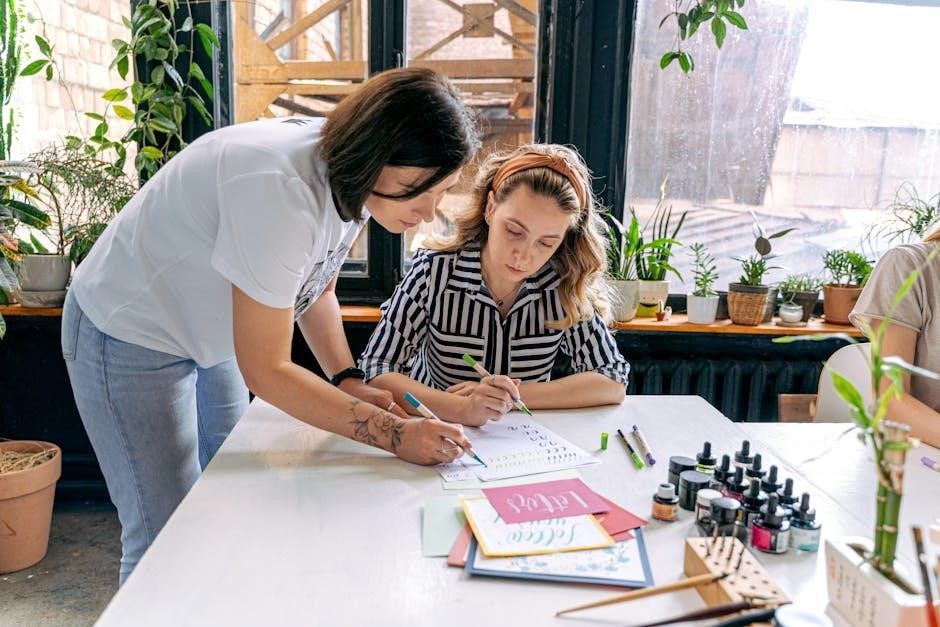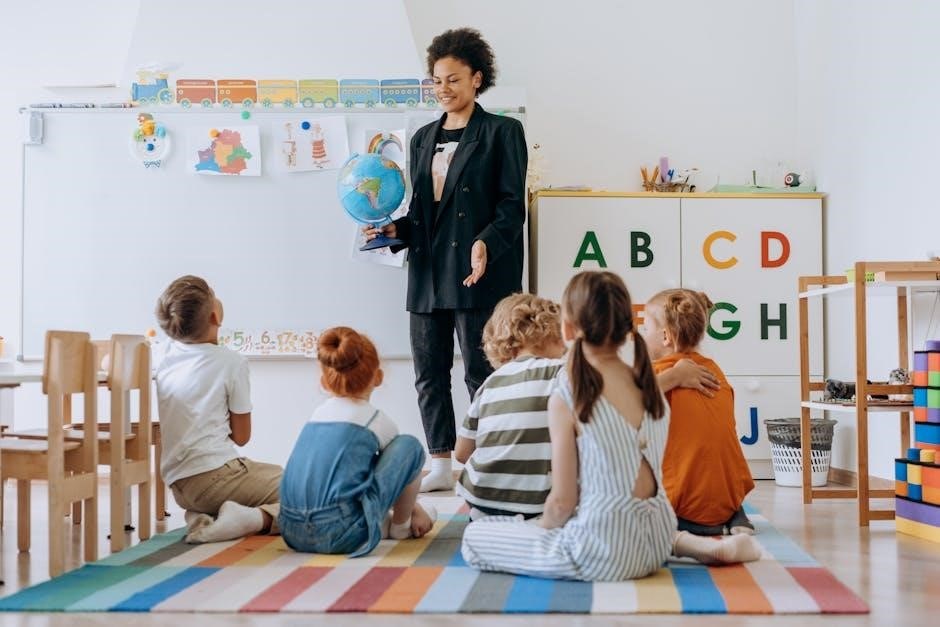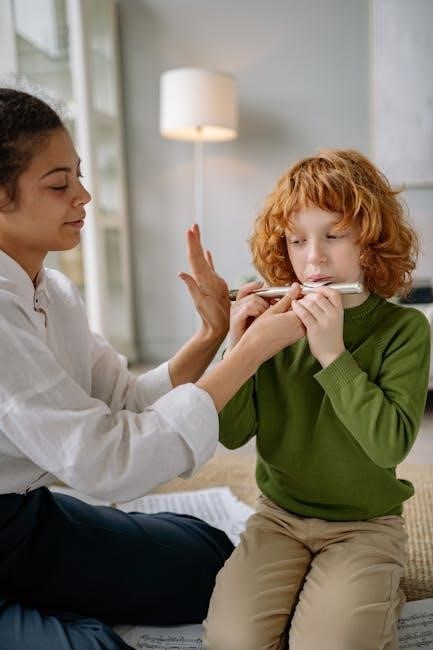A teacher serves as a guide, facilitating learning and exploration while creating an engaging environment. They scaffold co-inquiry, inspiring discovery and independence, essential for student growth and societal development.

The Role of a Teacher as a Guide
A teacher acts as a mentor and facilitator, scaffolding learning experiences to inspire curiosity and independence while guiding students through discovery and co-inquiry.
Defining the Teacher’s Role as a Guide
The teacher’s role as a guide involves facilitating learning through mentorship, scaffolding, and co-inquiry. They create environments that encourage exploration, discovery, and independence, rather than dictating knowledge. Guides inspire curiosity, support skill development, and help students navigate challenges. This role shifts from traditional teaching to fostering active participation, enabling students to take ownership of their education. The guide ensures learners are prepared for life’s complexities, acting as a broker of learning opportunities. This approach emphasizes collaboration, creativity, and critical thinking, aligning with modern educational goals. Ultimately, the teacher as a guide empowers students to thrive academically and personally.
The Teacher as an Expedition-Educator
The teacher as an expedition-educator navigates alongside students, guiding co-inquiry and fostering collaborative learning. This role involves scaffolding experiences, encouraging exploration, and creating pathways for discovery. Unlike a tour leader, the expedition-educator does not follow a rigid agenda but adapts to student needs, promoting independence and critical thinking. By embracing this stance, teachers facilitate deeper understanding and prepare students for real-world challenges. The expedition-educator role emphasizes active participation, creativity, and problem-solving, aligning with inquiry-based education. This approach transforms the classroom into a dynamic, student-centered environment where learning is an adventure of discovery and growth.

Lesson Planning and Guidance

Lesson planning is the cornerstone of effective teaching, guiding educators in orchestrating engaging and purposeful student learning experiences.
Strategies for Effective Lesson Planning
Effective lesson planning involves aligning activities with learning objectives, differentiating instruction for diverse learners, and integrating technology to enhance engagement. Teachers should prioritize clear, measurable goals and incorporate formative assessments to monitor progress. Cross-curricular connections and real-world applications make lessons more relevant, fostering deeper understanding. Flexibility is key; plans should adapt to student needs and interests. Collaborative activities and hands-on experiences encourage active participation. Additionally, leveraging resources like teacher guides and educational tools supports robust instruction. By thoughtfully designing lessons, educators create a dynamic, inclusive learning environment that guides students toward academic and personal growth.

Adapting Lesson Plans for Diverse Learners
Adapting lesson plans for diverse learners ensures inclusivity and caters to varying abilities, learning styles, and cultural backgrounds. Teachers can use differentiated instruction, incorporating tiered assignments and learning centers. Universal Design for Learning (UDL) principles help create flexible, engaging lessons. Leveraging technology, such as interactive tools, enhances accessibility. Additionally, integrating cross-curricular connections and real-world applications makes content more relevant. Teachers should also utilize free online resources, like teacher guides, to support tailored instruction. By addressing individual needs, educators foster an inclusive environment, promoting equity and maximizing each student’s potential for growth and success in their educational journey.
Creating an Engaging Classroom Environment
Teachers thoughtfully prepare classrooms with enticing materials and activities, fostering active learning and exploration. This setup encourages students to engage meaningfully, promoting curiosity and intellectual growth.
Preparing a Classroom Environment for Active Learning
Teachers create dynamic learning spaces by thoughtfully arranging materials and activities that inspire curiosity and engagement. A well-prepared environment encourages students to explore, collaborate, and take ownership of their learning. By incorporating manipulatives, interactive tools, and technology, educators foster hands-on experiences that cater to diverse learning styles. Flexible seating arrangements and accessible resources promote movement and collaboration, breaking away from traditional static setups. This intentional design not only enhances focus but also empowers students to navigate their educational journey independently. The classroom becomes a hub where active participation and discovery thrive, guided by the teacher’s strategic preparation and facilitation.
Materials and Activities to Entice Students
Teachers entice students with diverse materials and activities that cater to varied learning styles. Cross-curricular resources, manipulatives, and interactive tools spark curiosity and engagement. Technology integration, such as educational apps and SMARTBoard templates, enhances participation. Hands-on activities and real-world applications make learning relatable and fun. Students are motivated by materials that encourage exploration and creativity, fostering a deeper connection to the subject matter. Additionally, incorporating free worksheets, thematic units, and collaborative projects extends learning beyond the classroom. These resources not only engage students but also empower them to take ownership of their educational journey, preparing them for future challenges with confidence and curiosity.

Facilitating Learning Through Exploration
A teacher facilitates learning through exploration by creating environments that encourage discovery and independence, guiding students to navigate challenges and fostering a spirit of inquiry and growth.
Encouraging Discovery and Independence
Teachers play a pivotal role in fostering independence and curiosity by creating environments that encourage students to explore freely. By posing open-ended questions and promoting hands-on activities, educators empower learners to take ownership of their education. This approach not only builds confidence but also cultivates critical thinking and problem-solving skills. Providing the right resources and support, teachers guide students to navigate challenges independently, helping them develop a growth mindset. This emphasis on self-directed learning enables students to become lifelong learners, capable of thriving in an ever-evolving world. Through such guidance, teachers inspire students to embrace discovery and grow into independent thinkers.

The Role of the Teacher in Co-Inquiry
The teacher’s role in co-inquiry is to act as a collaborative partner, guiding students through shared exploration and discovery. By scaffolding learning experiences, educators enable students to take ownership of their inquiries while providing strategic support. This approach fosters critical thinking, creativity, and problem-solving skills. Teachers facilitate dialogue, encourage questioning, and create an environment where students feel confident to explore ideas. Acting as a co-learner, the teacher models curiosity and resilience, helping students navigate challenges and deepen their understanding. This collaborative dynamic empowers students to become independent thinkers and lifelong learners, while the teacher’s expertise ensures meaningful guidance throughout the process.
Professional Development for Teachers
Professional development empowers teachers with resources, tools, and continuous learning opportunities, fostering growth and enhancing their ability to guide students effectively in evolving educational landscapes.

Resources and Tools for Teacher Growth
Teachers benefit from diverse resources and tools designed to enhance their professional growth. Free online guides, such as lesson plans, SMARTBoard templates, and worksheets, provide structured support. Curriculum Associates’ Teacher Toolbox offers research-based materials for flexible instruction. Scholastic’s teaching tools include printables, book lists, and expert advice to enrich classroom experiences. These resources cater to various teaching styles, enabling educators to adapt and innovate. Continuous learning opportunities, like webinars and workshops, further empower teachers. Accessible through smartphones or interactive whiteboards, these tools ensure educators can seamlessly integrate new strategies, fostering a dynamic and effective learning environment for both teachers and students.
The Importance of Continuous Learning
Continuous learning is essential for teachers to stay updated with educational advancements and technologies. It enables them to adapt teaching methods to meet diverse student needs and implement new curriculum requirements effectively. This ongoing process ensures teachers remain competent and innovative, fostering a dynamic classroom environment. Continuous learning also allows educators to explore new strategies and tools, enhancing their ability to guide students successfully. By prioritizing ongoing education, teachers can address emerging challenges and opportunities, ensuring they remain effective guides in their students’ learning journeys, ultimately improving student outcomes and educational success.
